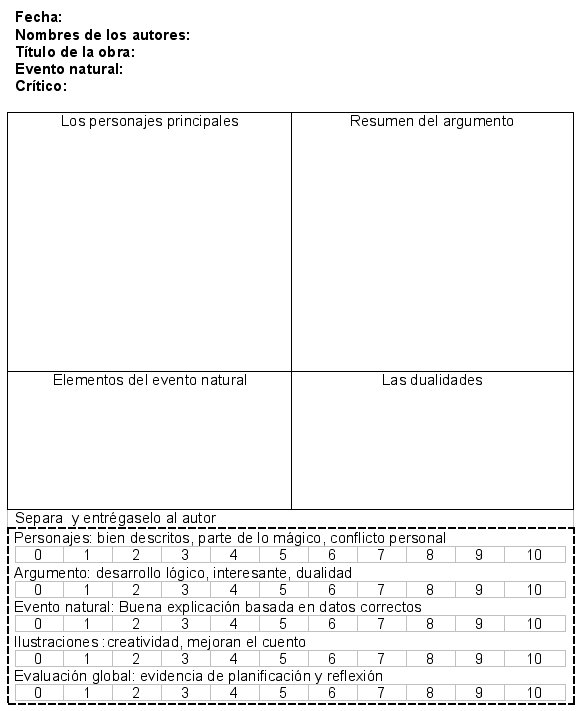
|
Title |
Una leyenda original |
|
Unit/Activity No. |
Natural Disasters/Activity 8 |
|
Geographic Topic |
legends based on physical phenomena |
|
Language Topic |
weather, places, celebrations, academic content |
|
Language Function |
describe, narrate in past time |
|
Language Standard |
1.3, 3.1 |
|
Geography Standard |
4, 6, 10 |
| Step 1. | Before class prepare a handout and a transparency. Using transparency 1 on Leyendas y mitos, review the elements that are part of these oral traditions. |
| Step 2. | Brainstorm with the students other possible natural events/phenomena, such as the formation of the Ring of Fire, tsunamis, formation of canyons, lakes, mountains, islands, rivers, floods, and earthquakes. Make a list on an overhead transparency as the students give their ideas. |
| Step 3. | Form the class into pairs. Using the list from Step 2, ask the students to choose one of the topics or offer a related one that is acceptable to the theme. The pairs are to write and illustrate a legend or myth that explains the origin of the natural phenomenon. |
| Step 4. |
Using Transparency 2, explain to the students what they need to include in their myth or legend: · A way to explain the natural event based on correct geographic explanations but explained in a simple manner as our ancestors would have done it |
| Step 5. | Set a due date for all stories to be completed. |
| Step 6. | Set up an Authors’ Share group format: Three students form into a group that does not include the original partner. In turn, each student reads his/her story to the others in the group, sharing the illustrations. The others in the group will then have an opportunity to ask questions about the story, whether it be motive or character development. On the graphic organizer that is included with the activity, the listeners will also fill out an evaluation that is handed to the author. At the end of the activity, the author will staple all the evaluations together and hand them in. Depending on the amount of time spent on this activity, students could then form new groups of 3 with different partners and repeat this process. |
This activity works even better in a large room like a cafeteria where there is not as much interference from other groups. This also can be a prelude to students going to lower level classes or even to elementary and middle schools to read their stories.
Handout 1

Transparency 1
Leyendas y mitos
La naturaleza
Explicar lo inexplicable
Las obras artísticas y arquitectónicas
La tradición oral
La dualidad
· lo bueno y lo malo
· el día y la noche
· la oscuridad y la luz
· el cielo y el infierno
· la vida y la muerte
· lo blanco y lo negro
Transparency 2
· Explicar el origen del fenómeno de manera simple a base de los datos geográficos correctos, cómo nuestros antepasados habrían percibido un evento natural
· El uso de por lo menos dos factores de la dualidad dentro del cuento
· El uso del pasado (pretérito, imperfecto, pluscuamperfecto) para contar el mito o la leyenda (con algún uso del presente donde corresponde)
· La inclusión de ilustraciones para embellecer el cuento
· un mínimo de 500 palabras
· Un bosquejo o “storyboard” visual del cuento, aprobado por el maestro
· Una versión final escrita a máquina e ilustrada (por mano, con gráficos de la computadora, etc.)
· Dos ejemplares del cuento con la portada ilustrada
· Otros toques creativos